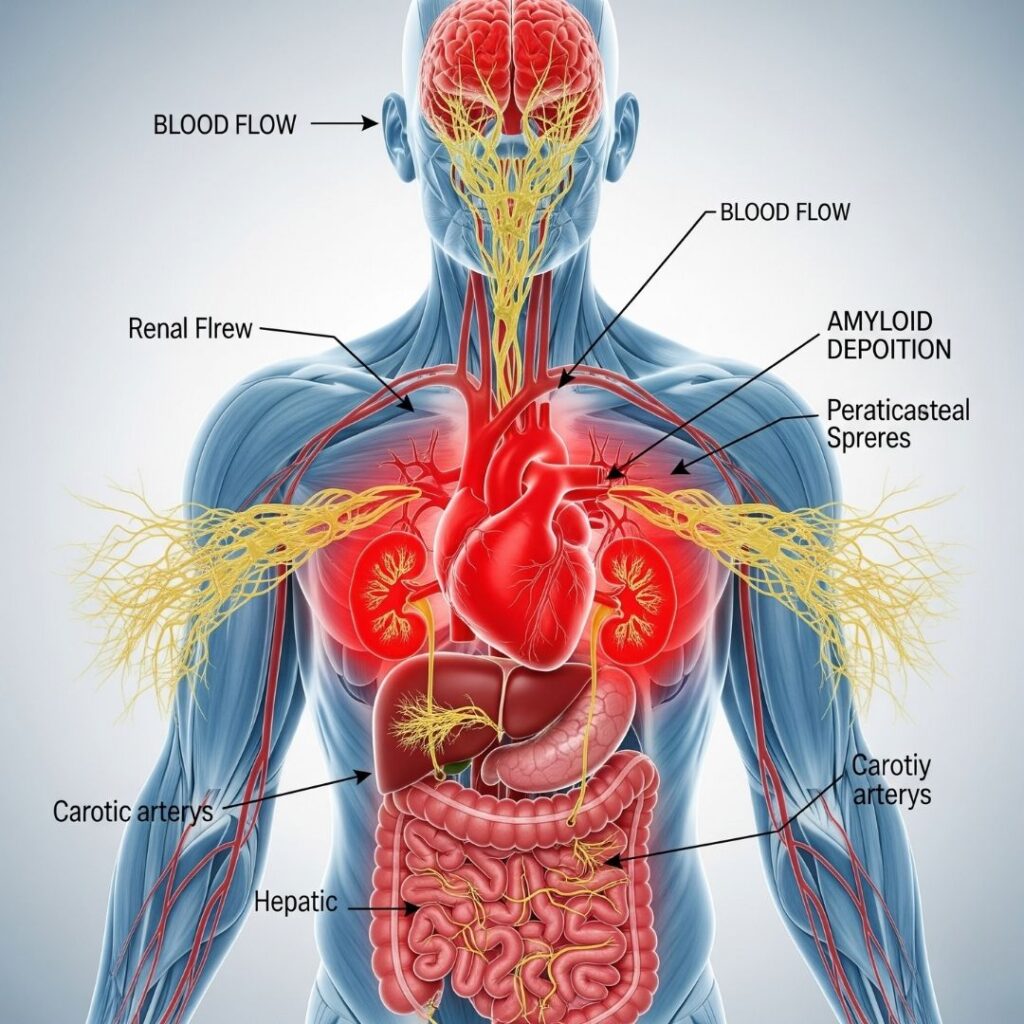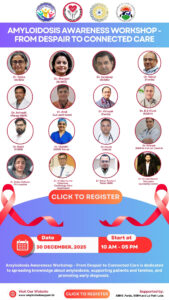Why Are Some Organs More Vulnerable to Amyloid Deposition?
Table of Contents

1. Introduction to Amyloidosis
Amyloidosis refers to a collection of uncommon yet dangerous conditions that are featured by the buildup of misfolded protein fibrils—also referred to as amyloid—within organs and tissues. These deposits are toxic, disrupt normal cell function, and cause progressive harm.
There are various types of amyloidosis, including:
- AL (Light-chain) Amyloidosis
- AA (Serum Amyloid A)
- ATTR (Transthyretin-related)
- Aβ (in Alzheimer’s Disease)
Although amyloid can theoretically affect any organ, in reality, certain organs are more often and severely involved.
2. What Is Organ Vulnerability in Amyloidosis?
Organ vulnerability is the preference of amyloid fibrils to accumulate in certain organs over others. Selectivity dictates the presentation, severity, and outcome of amyloidosis.
For instance:
- In AL amyloidosis, the kidneys and heart are most frequently affected.
- In ATTR amyloidosis, nervous system and heart are targeted early.
- In AA amyloidosis, kidney involvement prevails.
Knowing why certain organs are more susceptible aids in early detection, selective monitoring, and the formulation of organ-directed therapeutic approaches.
3. How Amyloid Forms and Is Deposited
Amyloid fibrils form when normally soluble proteins fold abnormally into β-sheet structures, which accumulate and evade clearance by the body.
Key steps in deposition:
- Protein misfolding (as a result of mutations, inflammation, or overproduction)
- Fibril formation and aggregation
- Extracellular deposition within tissues
- Local inflammation and organ dysfunction
Deposition is not random but instead occurs in patterns determined by:
- Tissue structure
- Protein affinity
- Organ-specific receptors or clearance pathways
4. Why Are Some Organs Targeted More Than Others?
Various biological, anatomical, and functional aspects account for organ selectivity in amyloidosis. These include:
- Blood supply: Organs with high-perfusion rates are subject to more circulating amyloid precursors.
- Filtration or detox functions: Organs such as the kidneys and liver filter large amounts of blood and waste by their nature.
- Structural complexity: Organs such as the heart and nervous system are under even minimal structural stress.
- Immunological and inflammatory milieu: Local immune responses can affect amyloid retention.
5. The Role of Blood Flow and Vascular Permeability
Organs with high perfusion and permeable capillaries are more vulnerable to amyloid deposition.
Example Organs:
- Kidneys: 20–25% of cardiac output; glomerular filtration makes them susceptible to plasma amyloidogenic proteins.
- Liver: Double blood supply (hepatic artery and portal vein) and sinusoidal endothelium facilitate free passage of proteins.
- Heart: Perfusion is continuous, and exposure to plasma proteins renders it a common target.
High flow enhances exposure time, and enhanced vascular permeability enables readier passage of fibrils into the interstitial spaces.
6. Structural Sophistication and Cellular Susceptibility
The more structurally or functionally sophisticated an organ, the more susceptible it is to perturbation from extracellular protein aggregates.
Heart:
- Myocardial cells rely on faithful electrical conduction and rhythmic contraction. Even minor amyloid deposits can lead to arrhythmias or heart failure.
Nerves:
- Axonal transmission requires intact myelin and membrane potentials. Amyloid damages peripheral nerves, leading to neuropathy.
The loss of even a few millimeters of structure in such organs has dramatic clinical consequences.
7. Specific Organ Vulnerability Explained
Let’s go through some major organs usually affected by amyloidosis.
Kidneys
Why vulnerable?
- Heavily involved in the filtration of blood
- Subjected to large quantities of plasma proteins
- Highly susceptible glomerular structure
Common manifestations: - Proteinuria (mainly albumin)
- Nephrotic syndrome
- Progressive renal failure
Amyloid deposition sites: Glomeruli, mesangium, and tubulointerstitial space
Heart
Why vulnerable?
- Ongoing exposure to blood
- Sensitivity of electrical conduction system
- Low regenerative capacity
Common signs: - Restrictive cardiomyopathy
- Arrhythmias
- Heart failure
Amyloid deposition sites: Ventricular walls, conduction system, valves
Liver
Why vulnerable?
- Dual-source high blood flow
- Sinusoidal endothelial permeability
Common signs: - Hepatomegaly
- Mild elevations in liver enzymes
- Compression of hepatic architecture
Amyloid deposition sites: Space of Disse, around portal triads
Nervous System
Why vulnerable?
- Long, thin axons with high metabolic demands
- Change in barrier permeability in some instances
Common signs: - Peripheral neuropathy
- Autonomic dysfunction
- Carpal tunnel syndrome
Amyloid deposition sites: Endoneurium, perineurium, dorsal root ganglia
Gastrointestinal Tract
Why vulnerable?
- Abundant vascular supply
- Intimate contact with immune tissue
- Ongoing exposure to systemic proteins
Common signs: - Malabsorption
- Bleeding
- Diarrhea or constipation
Amyloid deposition sites: Submucosa, muscularis propria, nerve plexuses
8. Comparative Organs: Why Some Are Spared
Organs such as the lungs, pancreas, and spleen are usually spared or mildly involved. Reasons are:
- Reduced exposure to circulating proteins
- Improved endothelial junctions
- Reduced structural sensitivity to small deposits
- Effective local immune clearance
By the way, no organ is entirely immune, particularly in severe systemic amyloidosis.
9. Influence of Amyloid Type on Organ Preference
AL Amyloidosis
- Most often involves kidneys, heart, liver
ATTR (Hereditary or Wild-Type)
- Preferentially deposits in the heart and peripheral nerves
AA Amyloidosis
- Usually occurs in kidneys, occasionally the liver and spleen
The biochemical characteristics of various amyloid proteins—size, charge, and hydrophobicity—also influence where they tend to deposit.
10. Diagnostic and Clinical Implications
Knowing about organ susceptibility is useful in:
- Early recognition of symptoms
- Focused diagnostic testing (e.g., ECG, urine protein, liver function tests)
- Biopsy site choice
- Treatment monitoring
Physicians can tailor management based on predicting which organs are at risk according to amyloid type.
11. Therapeutic Strategies Targeting Organ Vulnerability
Organ-Specific Management:
- Kidneys: Diuretics, ACE inhibitors, dialysis
- Heart: Loop diuretics, pacemakers, transplant in certain instances
- Nerves: Pain control, mobility assistance
- Liver: Symptomatic care, prevention of hepatotoxic medications
Disease-Modifying Therapies:
- Stabilizers (e.g., tafamidis for ATTR)
- Gene silencers (e.g., patisiran, inotersen)
- Proteasome inhibitors (e.g., bortezomib for AL amyloidosis)
- Monoclonal antibodies against amyloid deposits
12. Conclusion
Certain organs are more susceptible to amyloid deposition based on a mix of factors:
- High blood supply
- Complex structure
- Permeability of barriers
- Cellular metabolic and sensitivity
Knowledge of such susceptibilities facilitates earlier diagnosis, specific monitoring, and organ-based treatment in amyloidosis patients.
Further research into organ tropism and amyloid biology could reveal more effective strategies to prevent or reverse organ damage—ultimately better treating patients with this rare yet serious disease.
13. Frequently Asked Questions (FAQs)
Q1. Why do kidneys get affected first in many cases of amyloidosis?
Because they are responsible for filtering large amounts of blood and have a very porous glomerular membrane, through which the amyloid proteins can easily enter and deposit.
Q2. Are several organs simultaneously affected?
Yes, particularly in the more advanced amyloidosis. In AL and ATTR amyloidosis, multi-organ involvement is the rule.
Q3. Is the lung involved in amyloidosis?
Seldom. They are usually spared because of impenetrable endothelial barriers, but pulmonary amyloidosis does happen in a few instances.
Q4. Is the brain involved in systemic amyloidosis?
Not usually. But cerebral amyloid angiopathy (secondary to Aβ) exists in Alzheimer’s disease, a distinct type of localized amyloidosis.
Q5. Do treatments working early reverse organ damage?
It can stop further progress and correct function, particularly in the heart and kidneys, if initiated early. But severe damage is irreversible.

